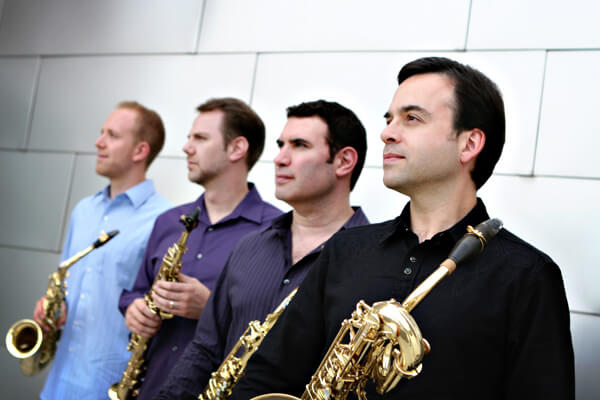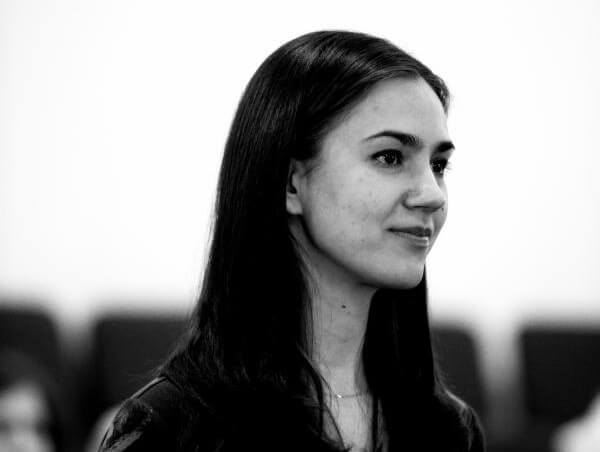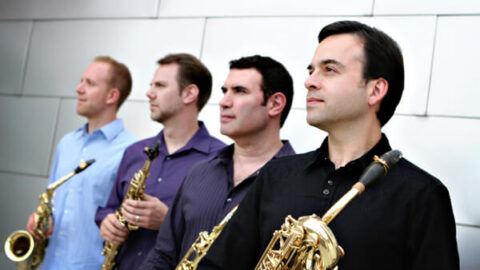![]() Prism Saxophone Quartet gave a solid performance of new works by Curtis Institute students and faculty in NYC at Christ & St. Stephen’s Church on May 10th. The church seemed the ideal setting to display the quartet’s sound, with gorgeous sonorities, jarring dissonances, and stratospheric intensities filling the room. Prism Quartet is one of those rare groups that can flawlessly perform new pieces one after the other with a tremendous sense of ensemble cohesion.
Prism Saxophone Quartet gave a solid performance of new works by Curtis Institute students and faculty in NYC at Christ & St. Stephen’s Church on May 10th. The church seemed the ideal setting to display the quartet’s sound, with gorgeous sonorities, jarring dissonances, and stratospheric intensities filling the room. Prism Quartet is one of those rare groups that can flawlessly perform new pieces one after the other with a tremendous sense of ensemble cohesion.

The concert was the culmination of the Prism Quartet’s residency at the Curtis Institute, in which student composers got a chance to work with the quartet on their pieces. While undoubtedly this was a great learning experience for the students involved, the results were not quite on par with Prism’s performance ability. Overall the new compositions suffered from the same malady infecting too many young composers: an overuse of instrumental technique (particularly extended techniques) at the expense of musical substance. While there was something of interest in every piece, most used the full toolkit of the saxophone’s possibilities rather than picking material suitable to their musical aims. Thus there were too many extended trills, reaches above the saxophone’s normal register, pitch bends, etc. and not enough melody or exposition of solid ideas.
One standout from the student compositions was Katerina Kramarchuk’s The Dniester Flow. Notably, it did not use any extended techniques, instead drawing on the saxophone’s abilities at lyricism and rhythmic excitement. The constant flow and pulsation of the beginning ostinato had an off-kilter catchiness that stayed with me after the concert. Kramarchuk contrasted the ensemble interaction with moments of lyrical melody played by individual members of the quartet, which allowed for each performer’s expressivity to come alive and highlighted the four saxophone’s different timbres. Kramarchuk’s extra-musical inspiration—the Dniester River that runs through the Ukraine and her native Moldova—felt real and palpable in the music.

The other piece that stood out in the program was Short Stories by Jennifer Higdon, the composition chair at the Curtis Institute, which is becoming a standard in the saxophone quartet repertoire, and for good reason. In six movements, it paints musical pictures of different moods, places, and ideas, and appropriately draws on the myriad of sounds that the saxophone is capable of. Prism Quartet was impressive for their ability to flawlessly move through the constantly changing technical demands of the piece, and the result was full of energy and excitement.
Leaving aside my criticisms of the compositions, sounds emerged from the quartet that don’t get heard enough in concert halls. The resonance of the tenor and bari saxophones playing together in their low registers was particularly full and powerful, yet with a warmth to it that rounded out the sound. Prism Quartet displays a tremendous ability at dynamic contrasts, and soft passages were particularly beautiful in the church. Likewise, their attention to articulation helped bring the music to life in different ways, from rounded soft beginnings to biting accents. Though their sound is a bit too bright for my tastes, their blend as an ensemble is a rarity these days, and their years of experience playing together as a group are evident in their sound and performance.
All this provided great sounds to take in throughout the evening. The counter-veiling tendency was too many excursions into particularly the soprano saxophone’s extended register. A word of advice to composers: the soprano sax is not a flute or a violin, and beyond its normal register, even in the best hands, it sounds too shrill to really enjoy. This of course can work when the emotional demands of the music require an abrasive piercing quality, but heard over and over again it just (to reiterate) sounds too shrill. So to wrap up: some great sounds, a solid performance, and a few good compositions, but a bit of composer indulgence and too much emphasis on technique. It’s great to hear new works and give young composers a chance, but a little more emphasis on quality over quantity might give new music a better reputation.
–-
David Pearson is a saxophonist residing in NYC.
























